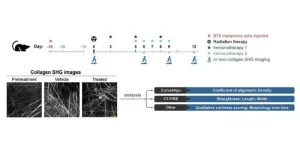(Press-News.org) Integration of pharmacies with physician practices, where on-site pharmacies open at physician practice locations, is a growing trend in cancer treatment. However, little is known about how this integration affects drug utilization or expenditures, along with other aspects of the patient experience.
A study published today in JAMA Network Open compared the outcomes of patients treated by oncologists whose practices integrated with pharmacies, to those of oncologists that did not integrate. Researchers found a slight increase in utilization of oral oncology drugs, but no significant change in expenditures on the drugs.
In addition, there were no discernible benefits for patients as measured by out-of-pocket expenditures, medication adherence, and the amount of time before treatment of cancer started.
The study’s lead author Genevieve Kanter, a senior fellow at the USC Schaeffer Center for Health Policy & Economics and associate professor at the USC Sol Price School of Public Policy, said the results were surprising, given the negative effects observed from other types of integration in health care. The growth of physician-pharmacy integration over the last 15 years had raised concerns about potentially increased drug utilization and spending and a shift towards more profitable and expensive oral cancer therapies.
On the other hand, the potential benefits of integration were also not observed in this study. Earlier, small-scale studies have suggested that pharmacy integration can reduce waste and help patients stay more adherent to their therapies by enabling closer patient monitoring.
For example, physicians with an on-site pharmacy could, in theory, prescribe drugs covering fewer days because patients would not need to wait as long for a new drug if an adverse event arises and there is a need to switch therapies.
But the current study’s authors say that with integration, they actually observed an increase in days’ supply of drugs instead of a decrease. Since reimbursements increase with each additional pill, oncologists may have been responding more to the additional revenues from increasing days’ supply instead of the increased flexibility permitted by on-site pharmacies. In addition, there was no change in patients’ adherence to medications.
“Overall, we find that integration of oncology practices with pharmacies has not resulted in changes in expenditures, which is a good signal for regulators, but it also has not resulted in significant benefits for patients, which is disappointing,” said Kanter. “Although there do not appear to be regulatory restraints required at the moment, our findings of different impacts on patients with different types of cancer, and emerging gaps for some patient outcomes, underscore the importance of continued study of pharmacy integration.”
Study examined outcomes for a range of cancer patients
Researchers conducted an observational study of oncologists and commercially insured patients treated by these oncologists between 2011-2019. Oncologists were tracked longitudinally through the study period, and patients were followed for 6 months after their initial diagnosis.
Study participants were patients aged 18-64 who had been diagnosed with advanced stage breast cancer, colorectal cancer, kidney cancer, lung cancer, melanoma, or prostate cancer.
The study focused on community oncologists who owned their own practice and were not part of a hospital or academic or medical teaching institution. Researchers noted this group experienced the most rapid increases in integration during the study period and likely derived the greatest financial benefit from pharmacy integration because of their direct ownership stakes in on-site pharmacies.
The authors found no changes in either oral drug spending or intravenous (IV) drug spending when they looked at all the cancers combined. However, when they examined the subsample of patients with breast cancer – the biggest group of cancer patients in the study sample – they found substitution between oral and IV drugs. Researchers found a 69% increase in oral drug expenditures, and concurrently a 34% decline in IV drug expenditures. But on net, there was no statistically significant change in total oral and IV drug expenditures.
“As we see most clearly with the breast cancer patients in our study, cancer treatment is shifting from intravenous drugs to oral drugs, and there are a ton of new oral drugs in the drug development pipeline,” said Kanter. “Meanwhile, physicians who used to be paid for administering IV drugs are now seeing their practices losing some revenues, as oral drugs are dispensed at the pharmacy.”
In 2012, 4.2% of community oncologists in the sample worked in practices with on-site pharmacies. By 2019, the final year studied, that percentage had increased to 27.6% of oncologists in pharmacy-integrated practices. Researchers say the underlying incentive to open integrated on-site pharmacies is to retain some of that drug revenue they used to get through physician-administered drugs.
Future research should focus on hospital-based oncology practices
“Proponents of medically integrated pharmacies in oncology practices believe the benefits include improved safety and quality, decreased time to fill prescriptions, and decreased waste. Others are concerned that these pharmacies may increase inappropriate use of expensive oral cancer therapies,” said David Debono, Carelon’s national medical director for oncology and a co-author of the paper. “Our study didn’t find evidence for either of these positions, but it was not designed to identify very specific details of care quality and safety. Further studies will be necessary.”
Study authors say future research should look at how hospital-based oncology practices, which have also rapidly increased their on-site dispensing, have adapted to pharmacy integration.
Researchers noted that hospital-based practices tend to be larger and may face a different set of financial incentives than community practices, and that the impact of integration may be different for Medicare-insured patients and vulnerable racial/ethnic and economic populations.
About the study
In addition to Kanter and Debono, the study’s authors include Pelin Ozluk, Winnie Chi, Michael J. Fisch, and Andrea DeVries of Carelon, Inc.; Ravi B. Parikh and Justin E. Bekelman of Perelman School of Medicine at the University of Pennsylvania; Mireille Jacobson of the Schaeffer Center and the USC Leonard Davis School of Gerontology.
The study was funded by the National Institute of Health Care Management Foundation.
END
Study: Integration of pharmacies with physician practices has little impact on cancer drug expenditures
Researchers found a slight increase in use of oral cancer drugs, but no significant change in expenditures on the drugs.
2024-05-24
ELSE PRESS RELEASES FROM THIS DATE:
Penn Medicine at the 2024 ASCO Annual Meeting
2024-05-24
CHICAGO – Researchers from Penn Medicine’s Abramson Cancer Center (ACC) and the Perelman School of Medicine at the University of Pennsylvania will present data on the latest advances in cancer research at the 2024 American Society of Clinical Oncology (ASCO) Annual Meeting, happening May 31—June 4, 2024 in Chicago and online. Follow @PennMedicine and @PennMDForum for updates.
Expert interviews
Experts from Penn Medicine are available to comment on a wide range of cancer research and care topics before, during, and after the meeting by video call, phone, or email. To arrange interviews, ...
Groundbreaking study connects genetic risk for autism to changes observed in the brain
2024-05-24
A groundbreaking study led by UCLA Health has unveiled the most detailed view of the complex biological mechanisms underlying autism, showing the first link between genetic risk of the disorder to observed cellular and genetic activity across different layers of the brain.
The study is part of the second package of studies from the National Institutes of Health consortium, PsychENCODE. Launched in 2015, the initiative, chaired by UCLA neurogeneticist Dr. Daniel Geschwind, is working to create maps of gene regulation across different regions of the brain and different stages of brain development. The consortium aims to bridge the gap between studies ...
NFL’s Buffalo Bills continue CPR education kicking off year 2 of the HeartBEAT initiative
2024-05-23
DALLAS, May 23, 2024 —According to American Heart Association data, 9 out of every 10 people who experience cardiac arrest outside of a hospital die. This is in part because they do not receive immediate cardiopulmonary resuscitation (CPR) more than half of the time. CPR, especially if performed immediately, can double or triple a person’s chance of survival. The American Heart Association and the Buffalo Bills want more people to be confident and capable when faced with a cardiac emergency. Through the HeartBEAT ...
Renewable grid: Recovering electricity from heat storage hits 44% efficiency
2024-05-23
Images
Closing in on the theoretical maximum efficiency, devices for turning heat into electricity are edging closer to being practical for use on the grid, according to University of Michigan research.
Heat batteries could store intermittent renewable energy during peak production hours, relying on a thermal version of solar cells to convert it into electricity later.
"As we include higher fractions of renewables on the grid to reach decarbonization goals, we need lower costs and longer durations of ...
Galaxies actively forming in early universe caught feeding on cold gas
2024-05-23
Researchers analyzing data from NASA’s James Webb Space Telescope have pinpointed three galaxies that may be actively forming when the universe was only 400 to 600 million years old. Webb’s data shows these galaxies are surrounded by gas that the researchers suspect to be almost purely hydrogen and helium, the earliest elements to exist in the cosmos. Webb’s instruments are so sensitive that they were able to detect an unusual amount of dense gas surrounding these galaxies. This gas will likely end up fueling the formation of new stars in the galaxies.
“These ...
Developing novel methods to detect antibiotics in vegetables and earthworms
2024-05-23
“The massive use of antibiotics and antimicrobials in people and animals has led to these substances appearing in unexpected environmental samples,” said Irantzu Vergara, researcher in the UPV/EHU’s IBeA group. Drugs that do not end up fully metabolised in the body reach the environment through various routes (such as manure, sewage sludge used as fertilisers, etc.), are leached into the soil and may end up transferring to crops or earthworms, which are at the base of the food chain. “Although ...
New biomarkers of response in melanoma immunotherapy
2024-05-23
Collagen, a major component of the extracellular matrix, plays a crucial role in tumor development. During the development of tumors (“tumorigenesis”), collagen fibers become linearized and densely deposited, hindering immune cell infiltration and promoting tumor metastasis. However, quantifying these collagen changes during melanoma progression has been challenging.
In-vivo imaging of collagen
As reported in Biophotonics Discovery, researchers from the Morgridge Institute for Research and University of Wisconsin – Madison recently addressed this challenge by using quantitative imaging to visualize collagen ...
AI headphones let wearer listen to a single person in a crowd, by looking at them just once
2024-05-23
Noise-canceling headphones have gotten very good at creating an auditory blank slate. But allowing certain sounds from a wearer’s environment through the erasure still challenges researchers. The latest edition of Apple’s AirPods Pro, for instance, automatically adjusts sound levels for wearers — sensing when they’re in conversation, for instance — but the user has little control over whom to listen to or when this happens.
A University of Washington team has developed an artificial intelligence system that lets a ...
Electromechanical material doesn’t get ‘clamped’ down
2024-05-23
HOUSTON – (May 23, 2024) – Lighting a gas grill, getting an ultrasound, using an ultrasonic toothbrush ⎯ these actions involve the use of materials that can translate an electric voltage into a change in shape and vice versa.
Known as piezoelectricity, the ability to trade between mechanical stress and electric charge can be harnessed widely in capacitors, actuators, transducers and sensors like accelerometers and gyroscopes for next-generation electronics. However, integrating these materials into miniaturized systems has been difficult ...
Most young women treated for breast cancer can have children, study shows
2024-05-23
In a study of nearly 200 young women who have survived breast cancer, most of those who tried to conceive were able to become pregnant and give birth
This study fills in major gaps from previous studies of fertility among breast cancer survivors
BOSTON – New research by Dana-Farber Cancer Institute investigators has encouraging news for young women who have survived breast cancer and want to have children.
The study, which tracked nearly 200 young women treated for breast cancer, found that the majority of those who tried to conceive during a median of 11 years after treatment were able to become pregnant and give birth to a child.
The findings, ...
LAST 30 PRESS RELEASES:
Your pet's flea treatment could be destroying the planet
Diabetes risk not associated with timing or type of menopause
Bulk inorganic crystals grown from water emit “handed” light
A new AI-based attack framework advances multi-agent reinforcement learning by amplifying vulnerability and bypassing defenses
While exploring the cosmos, astronauts also fuel explorations of the biology of aging and cellular resilience
Design and synthesis of Zr-IR825 nanoparticles for photothermal therapy of tumor cells
Food critics or food grabbers? When choosing food, wood mice split into careful examiners who sniff and handle, and quick nut grabbers
‘Cosmic clock’ reveals Australian landscapes’ history and potential future
Higher maternal blood pressure increases the risk of pregnancy complications, study concludes
Postoperative complications of medical tourism may cost NHS up to £20,000/patient
Phone apps nearly 3 times as good as no/basic support for quitting smoking long term
Female sex and higher education linked to escalating prevalence of obesity and overweight in Africa
THE LANCET + eCLINICALMEDICINE: Two studies on reductions in mortality from small changes lifestyle changes
AI model identifies how every country can improve its cancer outcomes
Young people risk drifting into serious online offenses through a slippery slope of high-risk digital behavior
Implant provides lasting relief for treatment-resistant depression
Autologous T cell therapy targeting multiple antigens shows promise treating pancreatic cancer
First extensive study into marsupial gut microbiomes reveals new microbial species and antimicrobial resistance
Study debunks myth of native Hawaiians causing bird extinctions
Tailored biochar could transform how crops grow, resist disease, and clean polluted soils
Biochar-based enzyme technology offers new path for cleaner water and soil
Biochar helps farmland soils withstand extreme rain and drought by steadying carbon loss
New study reveals major gaps in global forest maps
Ochsner Health names Dr. Timothy Riddell executive vice president and chief operating officer
Can future-focused thoughts help smokers quit?
From brain scans to alloys: Teaching AI to make sense of complex research data
Stem Cell Reports seeks early career editors to join the editorial board
Signs of ancient life turn up in an unexpected place
Pennington Biomedical researchers explore factors behind body’s ability to regulate weight
Zhongping Lee awarded the Nils Gunnar Jerlov Medal
[Press-News.org] Study: Integration of pharmacies with physician practices has little impact on cancer drug expendituresResearchers found a slight increase in use of oral cancer drugs, but no significant change in expenditures on the drugs.




